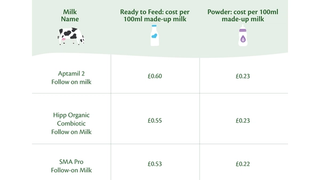
- Home
- Advice Hub
- Baby
- Baby Feeding
- Difference Between Powder Vs Ready To Feed
Difference between Powder vs Ready to Feed
We've listed some key considerations when choosing whether to feed your baby formula powder or ready to feed. We've created an easy guide on the differences here.
The decision to switch to formula milk isn’t always easy. Then you’re faced with choosing a brand – and a format (either powdered formula or ready to feed). There’s a lot to consider before you head to the supermarket baby aisle, so to help you make up your mind, we’ve listed out some key considerations.
1. Nutrition
Both powdered and Ready to Feed formula provide the same nutrition for your baby. All formula milks have to meet very strict compositional regulations, so you can be sure your baby will get the right nutrients, in the right quantity, from whichever formula you use.
However, sometimes there’s a very slight difference between powdered formula and Ready to Feed when it comes to the sources and values of different vitamins and minerals. You can always check the ingredients on the packs to see, but not many babies notice the difference.
One thing you might notice though is a slight difference in colour between powder and Ready to Feed. The Ready to Feed formulas undergo ultra-heat treatment, to sterilise them and keep them safe throughout their shelf life. This involves temperatures above 135 degrees C, which alters the colour and structure of the proteins in the formula, ever so slightly.
We’ve heard anecdotally, that this helps improve the formula’s digestibility. It hasn’t been proven in clinical studies, so there’s no scientific evidence to support this. But, if your baby is suffering with feeding problems, it could be an option. However, we always recommend getting help and guidance from your healthcare professional before making changes to your baby’s usual milk.

2. Cost
Using Ready to Feed formula will cost you more than making up a feed with a powdered formula. The table below shows a few examples of the difference in price across several leading infant formula brands. [1]
3. Convenience
Ready to Feed formula is incredibly handy. Ready to pour into a sterilised bottle or beaker, it’s ideal for days out, fuss-free night feeds, or any occasion when you’re away from home (and the necessary facilities for making powdered formula safely.) The downside is cost. Ready to Feed formula is significantly more expensive than powdered formula.
4. Safety
This is a really important consideration, whether you use a powdered or Ready to Feed formula. Powdered formulas are not sterile. So, it’s really important that you follow the preparation instructions on the pack carefully to help ensure the formula is safe and your baby doesn’t become ill.
Ready to Feed formulas are sterile so there is potentially less risk of infection. Whether you are using powdered formula or Ready to Feed remember all feeding equipment must be sterilised and clean.
5. Storage
Another consideration is space. If you choose to mainly use Ready to Feed formula, you’ll need to set aside quite a lot of cupboard space. The containers are bulkier than the boxes of powdered formula. In fact, one 800g pack of powdered HiPP Organic Follow on Milk will make up nearly six litres of formula, which is about the same as thirty 200ml Ready to Feed bottles of the same formula!
6. Environment
At HiPP, we’re proud of our recyclable packaging. But not all companies can meet the same high standards as us: Our box and scoop are easily recycled at kerbside and our RTF bottles are fully recyclable. Some of the packaging used by other companies isn’t as recyclable; like tetrapaks or some powder boxes.
References
- https://infantmilkinfo.org/costs/












